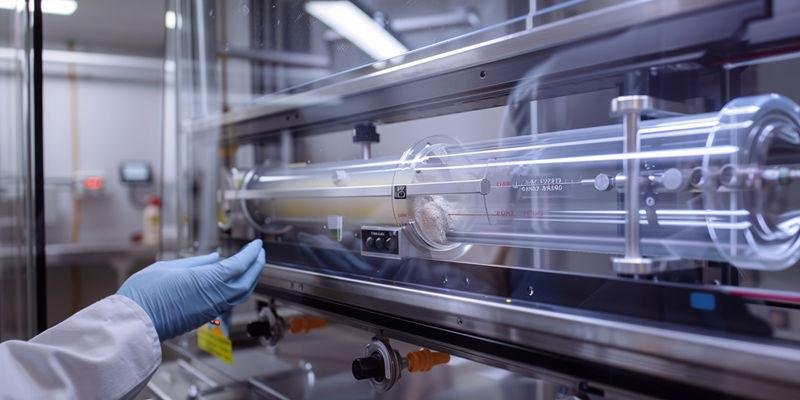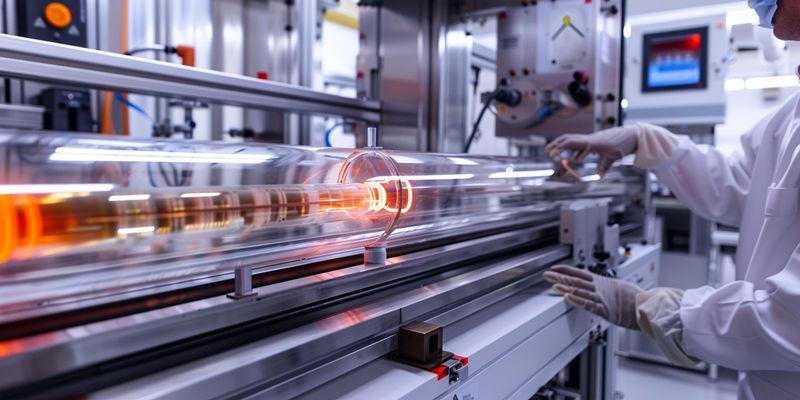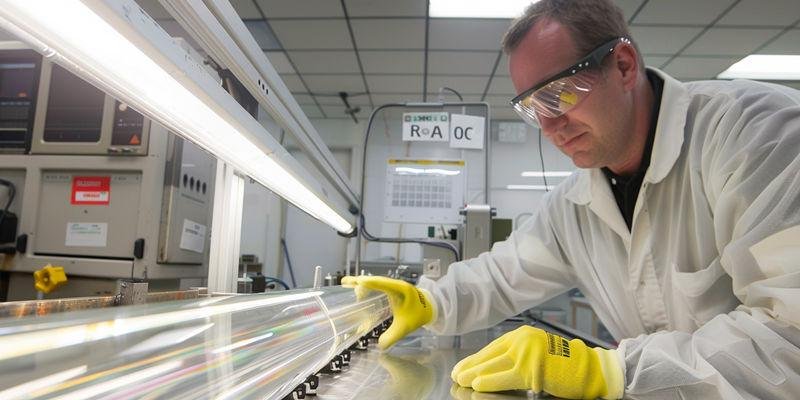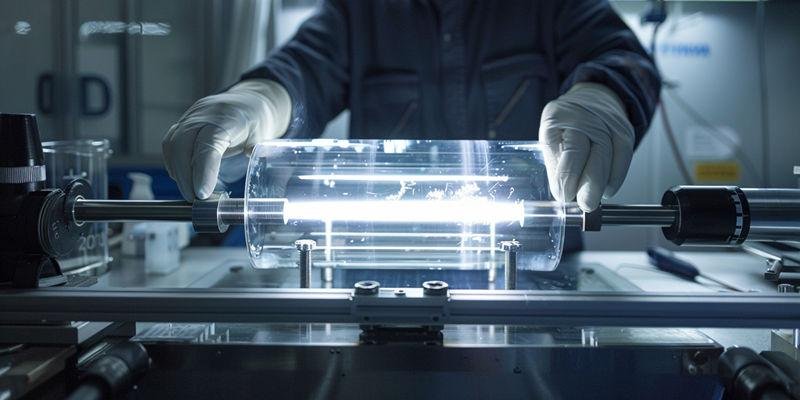
Matching tube length to furnace and process requirements drives engineering optimization and directly influences custom length quartz tube performance. Engineers achieve thermal uniformity, durability, and practical installation by selecting the correct tube length. This approach maximizes process efficiency and manages cost by reducing wasted energy and material.
Principales conclusiones
Selecting the right length-to-diameter ratio (8:1 to 15:1) ensures thermal uniformity and prevents structural weaknesses in quartz tubes.
Properly sizing the heated length and unheated extensions minimizes heat loss and maintains a stable temperature profile, enhancing process efficiency.
Longer quartz tubes face higher thermal stress, increasing the risk of failure; engineers should match tube length to the heated zone for optimal durability.
Custom tube lengths improve energy efficiency by reducing wasted heating, potentially lowering power consumption by up to 22%.
Considering installation constraints and maintenance needs helps engineers choose practical tube lengths, balancing performance with cost.
What Length-to-Diameter Ratios Optimize Thermal Uniformity?

Selecting the right length-to-diameter ratio is crucial for achieving thermal uniformity in quartz tube furnace applications. Engineers choose these ratios to balance heat distribution, structural stability, and material efficiency. Understanding why these ratios matter helps optimize custom length quartz tube performance for both process quality and operational reliability.
Length-to-Diameter Ratio Engineering Guidelines
Engineers select length-to-diameter ratios between 8:1 and 15:1 to ensure even temperature distribution and prevent structural weaknesses. These ratios help avoid excessive end-zone heat loss and minimize temperature gradients along the tube. Tubes outside this range often show uneven heating or increased risk of mechanical failure.
A ratio below 6:1 leads to significant heat loss at the ends, while ratios above 20:1 can cause temperature differences greater than 10°C per 100mm, making it difficult to maintain uniformity. ISO 7991 and TOQUARTZ data confirm that the 10:1 to 12:1 range offers the best balance for most furnace designs.
To summarize the key engineering guidelines:
8:1 to 15:1 ratio: Optimal for thermal uniformity and stability.
Below 6:1: High end-zone heat loss.
Above 20:1: Large temperature gradients and risk of uneven heating.
End-Zone Thermal Effects on Uniformity
End zones of quartz tubes lose heat more rapidly than the central heated region, which disrupts temperature uniformity. Engineers extend the heated length beyond the process zone to buffer these losses and maintain a stable temperature profile. Properly sizing the unheated extensions at each end reduces the impact of these losses on the process zone.
When the heated zone is too short relative to the tube length, more than 15% of input energy escapes through the ends, reducing efficiency. For example, a 600mm process zone typically requires at least 300mm of heated length at each end to minimize these effects and ensure uniformity across the working area.
Tube Ratio | End-Zone Heat Loss | Uniformity Impact |
|---|---|---|
<6:1 | >15% | Poor, high end loss |
8:1–15:1 | <10% | Good, stable temperature |
>20:1 | Variable | Risk of large gradients |
Thermal Expansion Accommodation in Length Selection
Thermal expansion in quartz tubes, though small, can cause stress if not properly managed. Engineers must allow for this expansion to prevent microfractures and extend tube life. Even minimal expansion, if constrained, leads to stress-induced failure over time.
The table below shows how microfracturing increases with temperature when expansion is not accommodated:
Temperatura (°C) | Observations on Microfracturing and Thermal Expansion |
|---|---|
200 | |
400 | Increased fracture nucleation, mica deformation |
700-800 | Interconnecting fracture network forms |
Proper support and expansion joints help maintain custom length quartz tube performance by reducing stress and preventing early failure.
How Does Tube Length Affect Thermal Cycling Durability?
Tube length plays a critical role in how quartz tubes withstand repeated heating and cooling cycles. Engineers must understand why longer tubes face higher thermal stress and how this impacts failure patterns. Selecting the right tube length-to-heated-zone ratio maximizes durability and extends service life in demanding furnace environments.
Temperature Gradient Stress Scaling with Length
Longer quartz tubes experience greater thermal stress during cycling because temperature gradients increase with length. When a furnace heats and cools, the difference between the hot center and cooler ends creates axial stress that scales with tube length. This stress can lead to microcracks and early failure if not properly managed.
Engineers observe that a 3,000mm tube with a 600mm heated zone develops nearly twice the axial stress of a 1,500mm tube under the same conditions. ASTM C1525 testing confirms that stress concentration rises 40-60% in extended tubes, making them more vulnerable during rapid thermal cycling. This relationship explains why tube length must be carefully matched to the process zone.
Key reasons for stress scaling with length:
Longer tubes: Higher temperature gradients and stress.
Shorter tubes: Lower stress, fewer failures.
Proper length selection: Reduces risk of thermal shock damage.
Length-Dependent Failure Mode Patterns
Tube length also determines the type and location of failure during thermal cycling. Short tubes most often fail through radial cracking in the hottest zone, while longer tubes show more longitudinal cracks in transition regions. These patterns result from how temperature gradients distribute stress along the tube.
Field data from over 6,000 furnace installations reveal that tubes longer than 2,500mm develop cracks in the transition zones, where the temperature drops sharply from the heated center to the cooler ends. In contrast, tubes under 1,000mm usually fail at the center due to concentrated heat. Understanding these patterns helps engineers design for longer service life.
Longitud del tubo | Common Failure Mode | Causal Factor |
|---|---|---|
<1,000mm | Radial cracking (center) | High central temperature stress |
1,200–2,000mm | Mixed (center and transition) | Balanced stress distribution |
>2,500mm | Longitudinal cracking (ends) | Large temperature gradients |
Optimal Length-to-Heated-Zone Ratios for Durability
Selecting the optimal tube length-to-heated-zone ratio is essential for maximizing durability. Tubes sized at 1.5 to 2.0 times the heated zone length achieve the best balance between stress distribution and service life. This ratio prevents excessive temperature gradients and reduces the risk of both radial and longitudinal cracking.
TOQUARTZ field analysis shows that tubes in the 1,200–1,600mm range for an 800mm heated zone last 30–40% longer than shorter or much longer tubes. Engineers choose these ratios to improve custom length quartz tube performance and minimize replacement costs. Proper ratio selection ensures reliable operation and fewer unplanned shutdowns.
Why optimal ratios matter:
Balanced stress: Prevents localized cracking.
Mayor vida útil: Reduces maintenance frequency.
Improved performance: Enhances process reliability.
What Installation and Handling Factors Drive Practical Length Limits?

Selecting the right quartz tube length involves more than just thermal performance. Facility access, maintenance needs, and safe handling practices all set practical boundaries for tube dimensions. Understanding why these factors matter helps engineers avoid costly installation issues and ensures safe, efficient furnace operation.
Facility Access and Installation Constraints
Facility layout and furnace design often limit the maximum tube length that can be installed. Engineers must consider door widths, enclosure sizes, and available clearance when specifying tube dimensions. These constraints directly affect whether a tube can be safely maneuvered into position without risk of breakage.
Industrial furnaces with split-shell designs allow longer tubes, but standard laboratory cabinets typically restrict tube length to 1,200–1,800mm. When access is limited, longer tubes may require special rigging or modifications, increasing installation complexity and cost. Choosing a tube length that matches facility access ensures smooth installation and reduces the risk of damage.
Furnace Type | Typical Max Tube Length | Access Limitation |
|---|---|---|
Laboratory Cabinet | 1,200–1,800mm | Door width, internal space |
Industrial Split-Shell | Up to 3,000mm | Requires handling equipment |
Maintenance Frequency Impact on Length Selection
Maintenance schedules and replacement costs play a key role in determining optimal tube length. Frequent tube changes make shorter tubes more practical, as they are easier to handle and less expensive to replace. This approach minimizes downtime and reduces labor requirements.
Longer tubes increase replacement time and often require two-person teams or mechanical assistance. For processes with high contamination risk or frequent tube changes, engineers select shorter tubes to streamline maintenance and lower costs. This strategy keeps operations efficient and reduces the total cost of ownership.
When considering maintenance needs, engineers often choose:
Shorter tubes for frequent replacement and lower cost.
Longer tubes only when process demands justify added complexity.
Optimized lengths to balance durability and ease of maintenance.
Handling Safety and Equipment Requirements
Safe handling of quartz tubes protects both workers and equipment. Longer tubes are more fragile and require careful support during installation and removal. Proper handling equipment, such as brackets or overhead cranes, becomes essential as tube length increases.
Workers must use gloves to prevent burns and chemical exposure, and always follow manufacturer instructions for installation. Regular checks for gas leaks and maintaining cleanliness further enhance safety. These practices reduce the risk of accidents and extend tube life.
Handling Practice | Por qué es importante |
|---|---|
Gentle handling | Prevents breakage |
Protective gear | Reduces injury risk |
Structural support | Avoids tube deformation |
How Do Custom Lengths Enable Process Optimization?
Custom tube lengths play a vital role in optimizing furnace processes. Engineers select precise dimensions to improve energy efficiency, enhance multi-zone control, and boost overall process performance. This section explains why tailored tube lengths matter for advanced furnace applications.
Energy Efficiency Through Length Optimization
Engineers choose custom tube lengths to minimize energy waste and maximize heating efficiency. When tube length matches the process zone, the furnace uses less power because it heats only the necessary area. This approach reduces unnecessary energy consumption and lowers operating costs.
CFD modeling and ISO 17411 thermal efficiency tests show that custom tubes eliminate unused heated zones, saving up to 22% in energy compared to standard stock tubes. TOQUARTZ consultation data confirms that matching tube length to the process zone improves temperature uniformity and reduces power input. Efficient tube sizing leads to better resource management.
A summary of energy efficiency improvements appears below:
Optimization Factor | Causal Relationship |
|---|---|
Precise tube length | Reduces wasted heating |
Matched process zone | Improves temperature uniformity |
Lower energy consumption | Decreases operating costs |
Multi-Zone Control Enhancement with Custom Lengths
Custom tube lengths allow engineers to position heating zones exactly where needed. This flexibility supports advanced multi-zone furnace designs, enabling precise control over temperature profiles for complex processes. Engineers can align zone boundaries with process requirements, improving product quality.
Furnace tube selection includes options for high-purity quartz and alumina, with customizable diameters and heating zone lengths. Comprehensive customization services support both production and R&D needs, making it possible to meet unique process demands. Custom tubes enhance control in multi-zone applications.
Key benefits of multi-zone control include:
Flexible zone placement: Aligns heating zones with process steps.
Customizable dimensions: Supports various furnace designs.
Improved product consistency: Maintains stable temperature profiles.
Process Performance Improvements from Tailored Dimensions
Engineers achieve superior process performance by specifying quartz tubes with exact dimensions. Custom tubes reduce contamination risks and improve reproducibility in high-precision manufacturing environments. Materials research institutes have reported a 40% improvement in experimental reproducibility after switching to custom-dimensioned tubes.
Quartz tube dimensions vary based on the semiconductor process, affecting heat distribution and gas flow. Custom designs, such as multi-chamber or tapered tubes, provide precise control over temperature and flow characteristics. Manufacturers can specify length, diameter, wall thickness, and tolerances to meet strict requirements.
The table below highlights customization aspects and their impact:
Customization Aspect | Descripción |
|---|---|
Longitud | Matches manufacturing needs |
Diámetro | Ensures uniform heat distribution |
Espesor de pared | Meets specific process requirements |
Tolerancias | Enables high precision |
Unique Features | Supports specialized applications |
What Length Specification Strategy Balances Performance and Cost?
Selecting the right quartz tube length requires a careful balance between performance and cost. Engineers must consider not only the initial purchase price but also energy use and replacement frequency over the tube’s service life. Understanding why a strategic approach to length specification matters helps organizations achieve both operational efficiency and long-term savings.
Análisis del coste total de propiedad
A total cost of ownership analysis reveals why initial price alone does not determine the best tube length. Energy consumption, installation labor, and replacement frequency all contribute to the true cost over time. Engineers who analyze these factors can identify the most cost-effective solution for their application.
They often use a formula:Optimal Length = Heated Zone + (2 × End Extension)
where End Extension accounts for thermal buffer, sealing, and handling needs. This approach ensures the tube supports process requirements while minimizing wasted material and energy. Data from TOQUARTZ shows that tubes sized within 100mm of the calculated optimal length reduce total ownership costs by up to 20%.
Key reasons to analyze total cost of ownership:
Energy efficiency: Shorter tubes matched to the process zone use less power.
Lower replacement costs: Properly sized tubes last longer and cost less to replace.
Reduced installation labor: Optimal lengths simplify handling and maintenance.
Standard vs Custom Length Economic Trade-offs
Choosing between standard and custom tube lengths involves weighing cost, lead time, and performance. Standard lengths offer lower prices and faster delivery, but may not align perfectly with process needs. Custom lengths provide precise fit and improved efficiency, but often come with a 25–35% price premium and longer lead times.
Engineers must decide why a custom length is justified. If the process demands tight temperature control or unique zone placement, the performance gains can outweigh the extra cost. For retrofits, measuring actual requirements prevents costly field modifications and ensures a proper fit.
Especificación | Standard Length | Custom Length |
|---|---|---|
Coste | Baja | 25–35% higher |
Plazos de entrega | 2–3 weeks | 4–6 weeks |
Rendimiento | Bien | Optimal |
Fit | May require adaption | Exact |
A strategic decision matrix helps engineers select the best option for both new and retrofit furnace applications.
Custom length quartz tube performance depends on precise engineering, operational flexibility, and economic efficiency. Engineers achieve optimal results by using data-driven length specification, which balances thermal uniformity, durability, installation, and cost. Recent industry reviews highlight the main benefits:
Benefit Type | Descripción |
|---|---|
Engineering | Precision machining and technical consultation for design optimization. |
Operational | Rapid prototyping and flexible production management. |
Economic | No minimum order quantity policy supports just-in-time manufacturing. |
Advancements in manufacturing, such as flame fusion and automated processes, further enhance customization and reliability:
Advancement Type | Descripción |
|---|---|
Fusión de llamas | Improves uniformity and clarity for robust applications. |
Precision Cutting | Increases dimensional consistency and product quality. |
Automated Manufacturing | Boosts efficiency and accessibility. |
New Quartz Compositions | Enhances thermal and chemical resistance for extreme conditions. |
A strategic approach to tube length selection ensures consistent furnace performance and long-term value.
PREGUNTAS FRECUENTES
Why does custom tube length improve furnace energy efficiency?
Custom tube length matches the heated zone to the process, reducing wasted energy. Engineers see up to 22% lower power consumption when the tube fits the process zone. This efficiency results from minimizing unnecessary heating outside the required area.
Consejo: Specify tube length based on process zone for best energy savings.
Why should engineers avoid using the longest available quartz tube?
Longer tubes increase thermal stress and risk uneven heating. Data shows tubes over 2,500mm develop more cracks and require complex handling. Engineers select optimal lengths to balance durability, uniformity, and installation practicality.
Longitud del tubo | Riesgo |
|---|---|
Optimal | Bajo |
Too Long | Alta |
Why does tube length affect maintenance frequency and cost?
Shorter tubes simplify replacement and reduce labor costs. Frequent maintenance schedules benefit from manageable tube lengths. Engineers choose shorter tubes for processes needing regular tube changes, lowering total ownership cost by up to 40%.
Puntos clave:
Short tubes: Easier handling
Lower cost: Less material
Faster replacement: Reduced downtime
¿Por qué la relación longitud/zona caliente es crítica para la durabilidad de los tubos?
La relación entre la longitud y la zona calentada controla la distribución de la tensión durante el ciclo térmico. Las relaciones entre 1,5 y 2,0 veces la zona calentada prolongan la vida útil en 30-40%. Los ingenieros utilizan esta relación para evitar el agrietamiento y maximizar la fiabilidad.
Nota: Una selección adecuada de la relación reduce las paradas imprevistas.
¿Por qué las limitaciones de instalación influyen en la especificación de la longitud de los tubos?
El acceso a las instalaciones, el equipo de manipulación y las normas de seguridad fijan los límites prácticos de longitud de los tubos. Los ingenieros tienen en cuenta la anchura de las puertas y el espacio disponible para evitar roturas. Los hornos industriales con el equipamiento adecuado permiten tubos más largos, mientras que los laboratorios requieren longitudes más cortas y manejables.
Restricción | Impacto en la duración |
|---|---|
Anchura de la puerta | Limita la longitud máxima |
Equipos de manipulación | Permite tubos más largos |
Directrices de seguridad | Restringe las dimensiones |




